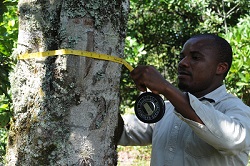Areas of work
FAO provides technical expertise across numerous work areas directly linked to the United Nations Framework Convention on Climate Change (UNFCCC) requirements to support countries as they become ready for REDD+ and later, during the implementation phase.
- FAO has long worked with forest monitoring and assessment to develop national forest monitoring systems and assessments to provide reliable forest resource information for national policy development, planning and sustainable management.
- In the context of REDD+, support is given to building a National Forest Monitoring System (NFMS) for forest and land monitoring using remote sensing, field-based forest inventory, and national greenhouse gases inventory. Building an NFMS involves many processes, such as the capacity to monitor forest-area change, to produce national forest inventories and to report on carbon stocks for the different pools.
- Forest Reference (emission) Levels (FRELs) and REDD+ results reporting allow countries to report on historical and current greenhouse gas emissions in the forest sector, and to build a benchmark for assessing mitigation.
- Safeguards and Safeguards Information Systems involve addressing and respecting the “Cancun safeguards”; developing a safeguards information system; and preparing summaries of safeguards information in accordance with the specific country context.
- REDD+ Strategic Documents include Readiness Preparation Proposals (R-PP), REDD+ national strategies or action plans and REDD+ national investment plans.
- FAO supports implementation of REDD+ actions to mitigate climate change in order to address the main drivers of deforestation and forest degradation in individual countries, as well as opportunities for enhancement of forest carbon stocks.
- REDD+ requires measures to ensure an enabling environment, including work on governance, policy and legal frameworks, and tenure. Further, countries are encouraged to ensure that REDD+ actions are generated through the participation of local, regional and national stakeholders.
- Gender equality and equity in a REDD+ context is also given priority as women and men use forests differently and have different roles, rights and responsibilities. Knowledge management, South-South cooperation and other exchanges are also supported to catalyze and facilitate learning, innovation and best practices.

The evolution of REDD+
FAO works with countries to build national capacity for REDD+ under the guidance of UNFCCC. REDD+ has been evolving since 2007 through successive agreements by the Conference of Parties of the UNFCCC with FAO’s technical support following the same path, adapting to meet the demands from countries advancing in their REDD+ efforts.
Through the enhanced national REDD+ capacity, countries have also helped to shape the emerging global REDD+ architecture, including the Warsaw Framework and the Cancun Agreement - an important part of the 2015 Paris Agreement on climate change. The implementation of REDD+ activities is also seen as a catalyst for strengthening efforts to implement the 2030 Agenda for Sustainable Development and countries’ Nationally Determined Contributions (NDCs).

